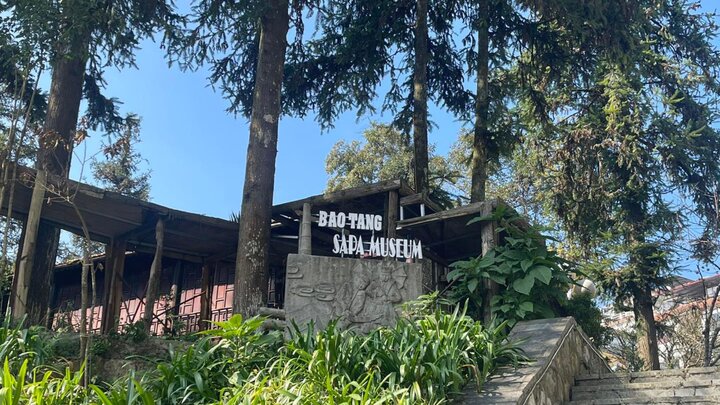1. Overview of Sa Pa Museum
1.1. Museum Address
Sa Pa Museum is located within the premises of the Lao Cai Provincial Information and Tourism Promotion Center, No. 02 Fansipan Street, Sa Pa Ward, Lao Cai Province. About 1.5 km from the center of Sa Pa town, the museum was built and officially opened in 2017. The space here is surrounded by lush ancient trees, bringing a sense of peace to visitors. This is also an ideal destination to learn about the cultural beauty and daily life of the ethnic groups in the Northwest region.
Under the green pine canopies and the characteristic misty fog of Sa Pa, the museum is like a 'memory-keeping house' – a place that respectfully preserves the historical imprints and cultural values of the land of Lao Cai.
1.2. Opening Hours, Ticket Prices, and How to Get to the Museum
- Opening Hours: From 07:30 – 11:30 and 13:30 – 17:00, all days of the week.
- Ticket Price: Free.
Most visitors depart from the center of Sa Pa town to reach the museum. The distance is only about 1.5 km, so you can choose any mode of transport that suits you.
If you love freedom, a motorbike rental per day with prices ranging from 150,000 – 200,000 VND/day will allow you to roam freely. The winding roads and wild flower slopes along the way will surely bring an exciting journey. Additionally, motorbike taxi rides with locals – at a price of only about 15,000 – 20,000 VND/person – are also a great way to hear more everyday stories of this land.
Meanwhile, taxis are the choice for those who want to get there quickly, with a price of about 20,000 – 30,000 VND/trip. It only takes a few minutes, and you'll be at the museum entrance.
And if you are the type who likes to enjoy things slowly, try walking. The road leading to the museum is shaded by trees, sometimes with a thin mist, bringing a feeling of freshness and romance. Every step is an opportunity to admire the mountain town, breathe in the cool air, and capture beautiful moments on your journey to explore Sa Pa.
2. Decoding the Charm of Sa Pa Museum
2.1. Unique Architecture of the Museum
Sa Pa Museum was built and established based on the tourism model of the town of Arcachon in the Bordeaux region (France), and is also the result of cultural cooperation between Lao Cai province and the Aquitaine region.
Stepping through the museum gate, visitors feel like they are entering a cool green space with ancient trees casting shade along the path, opening up a journey to discover a rich and diverse treasure trove of artifacts.
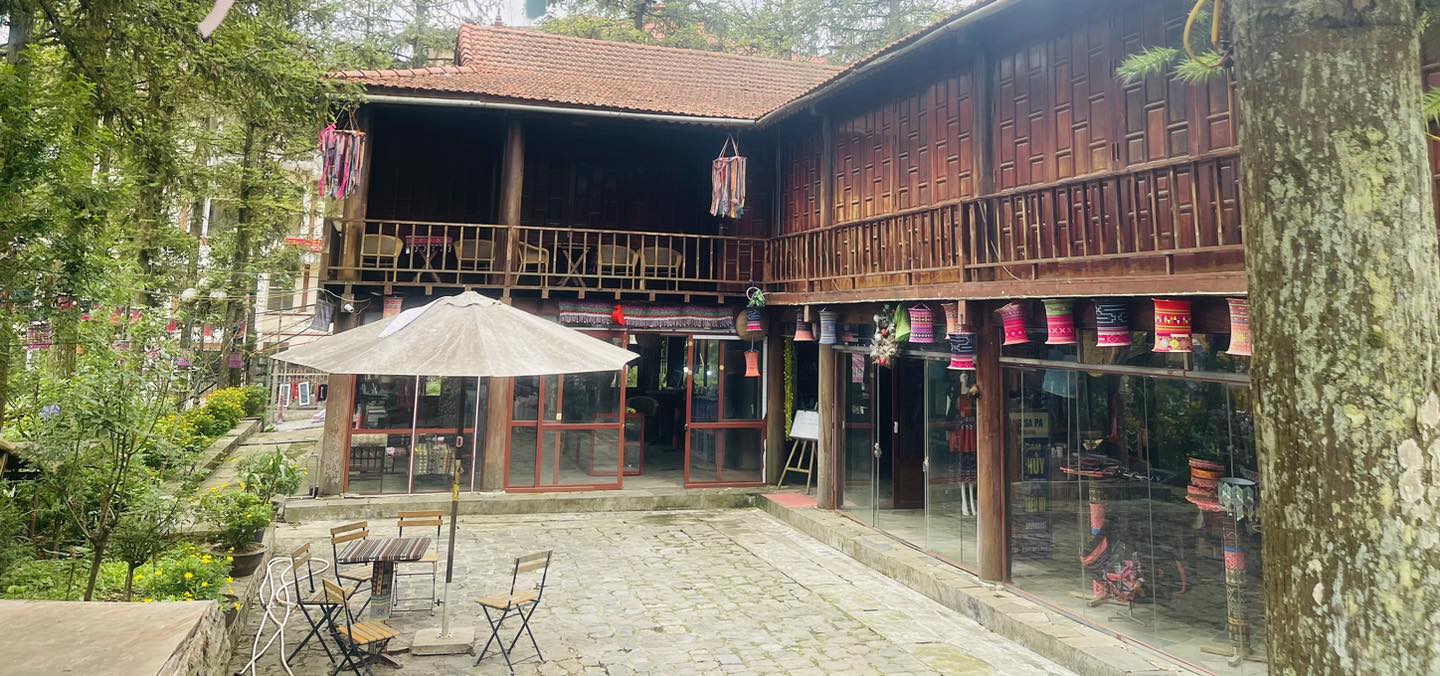
The stilt house space along with artifacts related to the daily life of the local people are preserved at Sa Pa Museum. (Source: Collected)
An interesting highlight here is the traditional wooden stilt house model, symbolizing the simple life of the Thai ethnic group in the villages of Hoang Lien Son. Inside, it is fully decorated with farming tools and daily living items, from familiar pestles and mortars to exquisite jewelry. Interspersed are also photos and artifacts recreating the folk beliefs of ethnic communities, offering visitors a realistic view of the spiritual life of the highlanders.
2.2. Cultural and historical values of the museum
Sa Pa Museum is not just a tourist stop, but also plays the role of a “memory repository” of the Northwest mountains. Here, hundreds of artifacts related to the daily life, customs, and beliefs of ethnic minorities are preserved, helping traditional values not to fade over time.
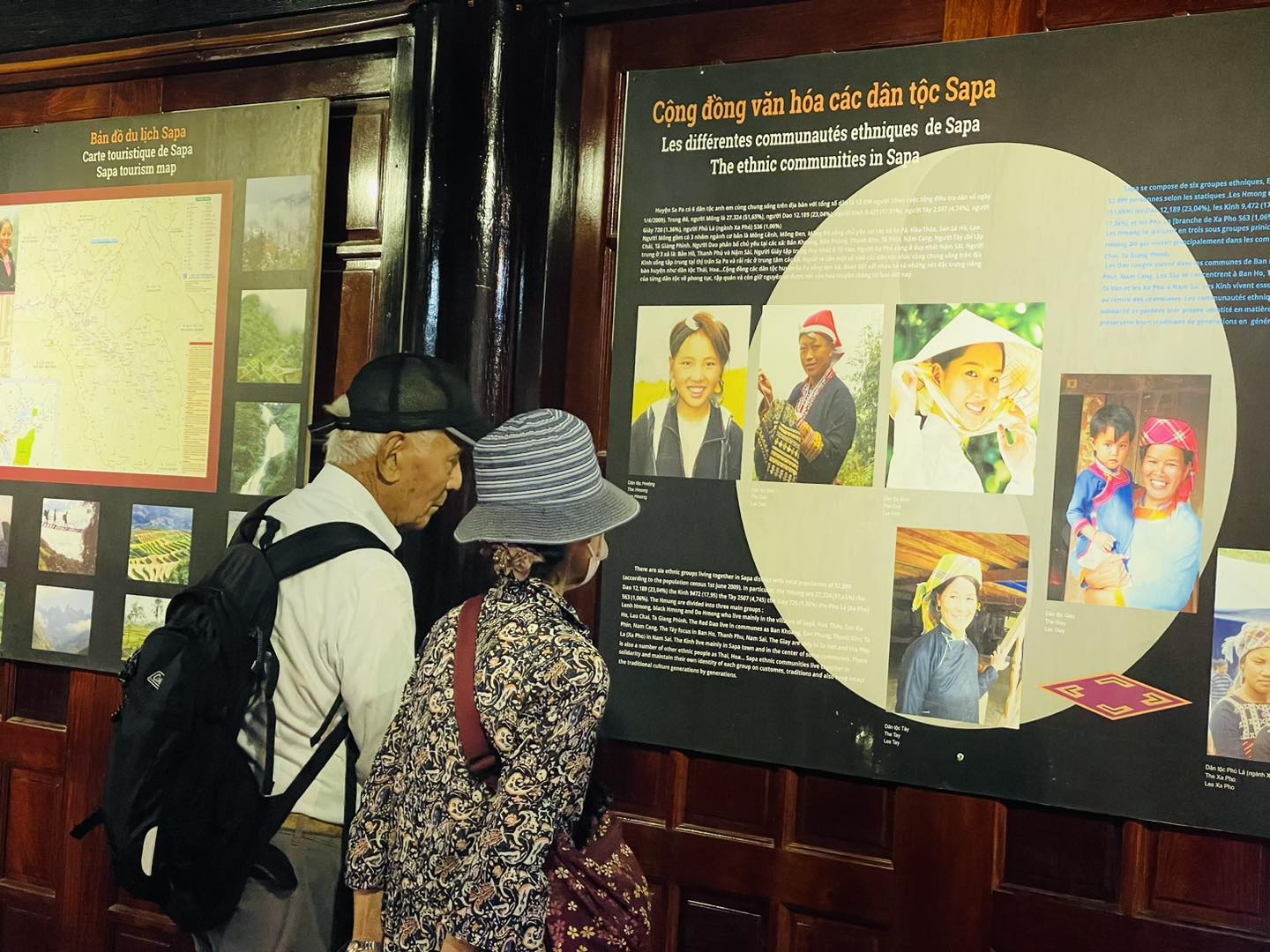
Sapa Museum offers visitors an intimate and vivid experience when admiring artifacts. (Source: Collection)
For young people and families, the museum offers an interesting learning experience. Instead of just reading in books, students have the opportunity to directly observe farming tools, costumes, jewelry, or simulated stilt houses, thereby gaining a better understanding of the history and culture of their homeland. This is also a way to evoke pride and love for national identity from the most familiar things.
Not stopping there, the museum is also a cultural rendezvous point, connecting visitors from all over with the local community. Stories told through artifacts, images, or display models not only help visitors explore the cultural depth of the Northwest, but also contribute to spreading the spirit of respecting heritage and preserving the past for future generations.
3. Explore the exhibition space of Sapa Museum
3.1. Exhibition themes and orientation
The exhibition space of Sapa Museum is designed as a journey taking visitors back to the traditional life of the indigenous ethnic groups. Here, scenes of daily labor, customs, beliefs, and community rituals are vividly recreated. Most prominent is the collection of traditional costumes with vibrant colors and exquisite patterns of the Hmong, Giay, Tay, Xa Pho, Ha Nhi, and Red Dao ethnic groups.

The artifact exhibition space recreates the daily working life of ethnic minorities in the highlands. (Source: Collection)
Furthermore, the exhibition area is also likened to a “bridge between the past and the present” by introducing hundreds of unique artifacts, from production tools, daily living items to objects of religious value. Thanks to scientific arrangement and updates to the 2025 trend, the museum helps visitors access historical knowledge while having a visual and emotional experience.
3.2. Displayed Artifacts
The exhibition space of Sa Pa Museum impresses visitors with its richness of artifacts, fully reflecting the cultural and spiritual life of the ethnic minorities in the highlands. Most prominent is the collection of traditional farming tools, from plows, hoes, bamboo baskets to hunting and gathering tools, all bearing the mark of a characteristic mountainous rice-growing agricultural civilization.
Besides, Sa Pa Museum also displays many silver and copper jewelry items along with colorful brocade fabrics, demonstrating the skill, exquisite aesthetic sense, and unique cultural identity of each ethnic group such as Hmong, Red Dao, Ha Nhi, or Tay.
Not only stopping at artifacts, the museum also dedicates a large space to introduce paintings and documentary photos capturing the majestic natural landscape of Lao Cai: golden terraced fields in the ripe rice season, the Hoang Lien Son mountain range shrouded in clouds, or the brilliant sunrise moment on Fansipan peak.

Artwork depicting the spectacular landscape on Fansipan peak amidst the clouds and sky of the Northwest. (Source: Collected)
Notably, many ritual models such as weddings, cap sac ceremonies, or worship rituals are elaborately recreated, helping visitors easily visualize how ethnic communities practice their beliefs in daily life. This is not only a vivid visual experience but also an opportunity to learn more deeply about the spiritual values of the ethnic people in the mountainous region of Lao Cai.
4. Suggested interesting experiential activities at Sa Pa Museum
4.1. Watching documentary films and images recreating Sa Pa past and present
Sa Pa Museum not only preserves artifacts but also possesses a large collection of documents, including documentaries, archival photos, models, and research publications. These valuable films and images vividly recreate the picture of Sa Pa through historical periods, from its early days as a wilderness to the bustling tourist town it is today.
Through them, visitors can gain a deeper understanding of the daily life, beliefs, customs, and traditions of ethnic minority communities such as H'Mong, Red Dao, Ha Nhi, Tay... who are closely associated with the land of Lao Cai.
4.2. Participating in experiential activities
The museum grounds also allocate a space for displaying and experiencing handicrafts. Here, visitors can admire exquisite products such as brocade clothing, handbags, headscarves... woven entirely from natural silk, with durable colors and characteristic traditional patterns.
The museum regularly organizes cultural exchange sessions, allowing visitors to try weaving, spinning, or making small souvenirs under the guidance of local artisans. This is an opportunity not only to admire but also to personally experience the quintessence of traditional handicrafts.
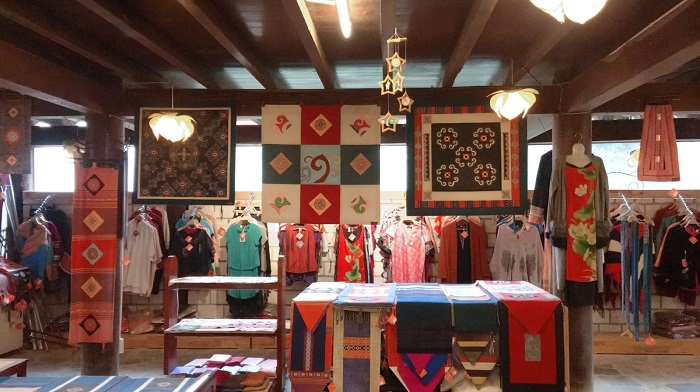
Vibrant brocade fabrics, crystallized from the skillful hands of ethnic highlanders. (Source: Collection)
4.3. Specialties to try when visiting the museum
After spending time exploring the precious artifacts and immersing yourself in the unique cultural space at Sa Pa Museum, visitors will surely want to enjoy more flavors of the mountains and forests. From the traditional Thang Co dish by the warm fire, to delicious fresh salmon hotpot in the chilly air of Sa Pa, each dish carries its own story, closely linked to local life and culture.
Notably, around the museum area, there are many famous restaurants where visitors can both taste local specialties and enjoy the atmosphere imbued with the spirit of the Northwest.
Here are some suggestions for famous restaurants near the Sa Pa Museum:
- A Quynh Thang Co Restaurant
Must-try dishes: Horse Thang Co, salmon hotpot – the most famous specialties of the highlands.
Ambiance: designed in a traditional stilt house style, creating a warm and cozy feeling.
Information: 15 Thach Son, Sa Pa. Opening hours: 09:00 – 23:30. Average price: 200,000 – 400,000 VND/person.
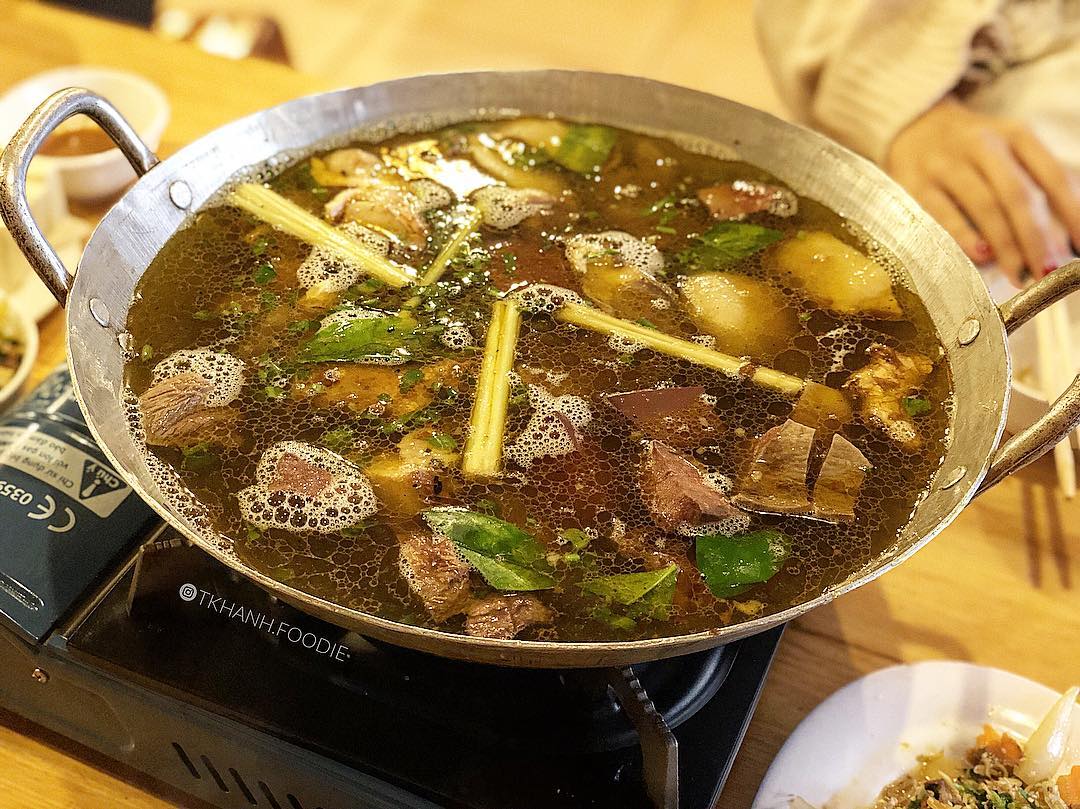
Thang Co hot pot is the signature dish of the Thang Co A Quynh restaurant. (Source: Compilation)
- Hai Lam Restaurant
Signature dishes: Salt-chili grilled chicken, steamed mountain pork – rustic flavors but delicately prepared.
Ambiance: cozy, simply but modernly decorated, creating a friendly feeling at first sight.
Information: 69 Xuan Vien, Sa Pa. Opening hours: 08:00 – 22:30. Average price: 200,000 – 300,000 VND/person.
- A Phu Sa Pa Restaurant
Must-try dishes: Thang Co, salmon salad, com lam grilled chicken, mountain pork – an attractive collection of highland cuisine.
Ambiance: spacious, close to the local traditional style.
Information: 15 Fansipan, Sa Pa. Opening hours: 09:00 – 23:00. Average price: 200,000 – 300,000 VND/person.

Specialty dishes at A Phu restaurant. (Source: Collected)
With this list of suggested restaurants, visitors can not only visit and experience the museum but also combine it with enjoying Sa Pa's specialty cuisine in 2025, to make the trip more complete and memorable.
5. Tips for visiting Sapa Museum
To have a truly complete and meaningful visit to the Sapa Museum, visitors should note some tips as follows:
5.1. Choose the right time
The museum is usually crowded on weekend mornings, so you can arrange to visit on weekday mornings or early in the afternoon to have more time to explore, take photos, and learn about the artifacts without too much crowding.
5.3. Dress appropriately
Prepare neat, polite attire that is convenient for moving around. If you intend to take photos in traditional costumes at the museum, you can choose simple, neutral-colored clothing to easily coordinate.
5.3. Behave politely
When visiting, you need to comply with the museum's regulations such as not touching the artifacts, not taking photos in prohibited areas, maintaining order, and not making noise that affects others. Protecting artifacts is also contributing to preserving cultural heritage for the community.
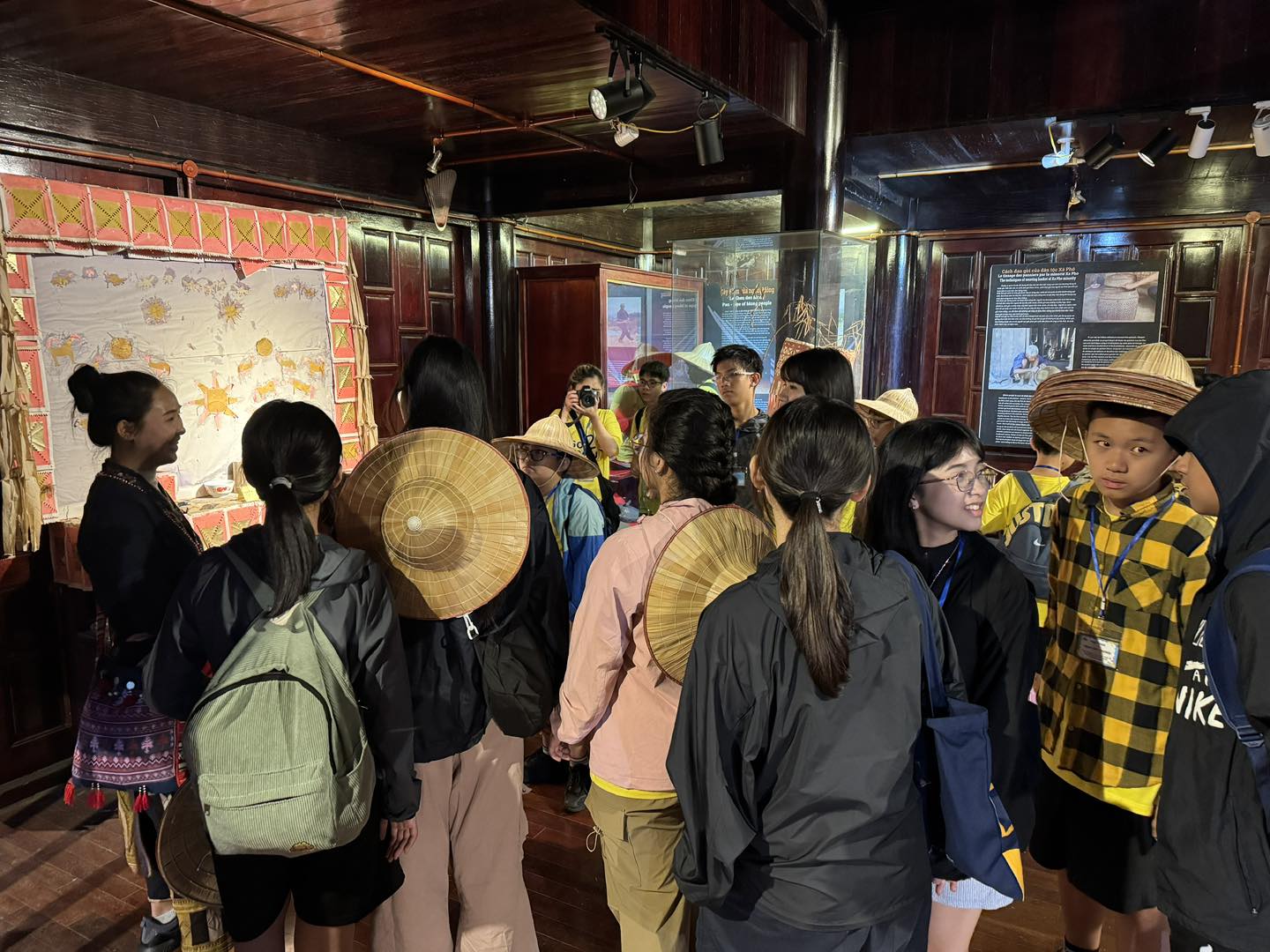
Preserve artifacts and common spaces – every visitor is a 'heritage protector'. (Source: Collected)
With these small notes, your tour will become more comfortable, meaningful, and help you have memorable experiences at Sa Pa Museum in 2025.
6. Suggested attractions around Sa Pa Museum
6.1. Sun World Fansipan Legend
Arriving in Sa Pa, the exploration journey will be more complete when you experience the Sun World Fansipan Legend cable car, which is the shortest route for tourists to conquer the 'roof of Indochina'. In just about 15 minutes of travel, the majestic scenery of the Hoang Lien Son mountain range unfolds before your eyes with golden terraced fields of ripe rice, mixed with the wild, mysterious beauty of the Northwest mountains and forests.
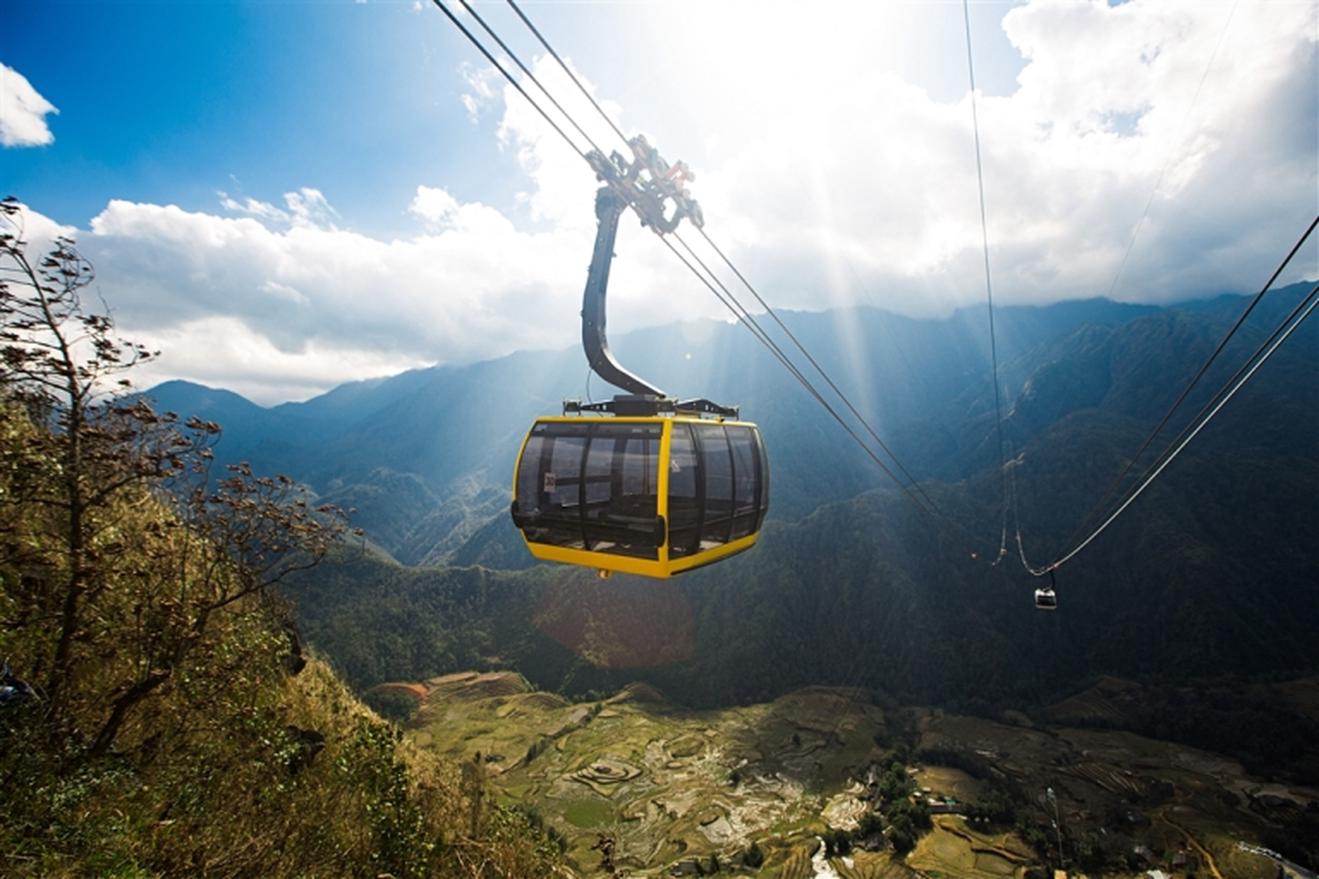
Experience the Sun World Fansipan Legend cable car – the shortest journey to conquer the ‘Roof of Indochina’. (Source: Compiled)
On days with drifting clouds, from the cabin, you can admire the Muong Hoa valley vibrant with flowers, like a poetic natural painting. Additionally, visitors can experience the mountain climbing train to gaze upon the majestic Hoang Lien Son valley from the brightly colored red train carriage.

The Muong Hoa cog railway takes visitors on a journey to admire the poetic Sa Pa valley from a unique perspective. (Source: Collected)
Don't forget to capture a memorable moment at the 3143m milestone, where every visitor who sets foot there wants to check-in once.
Additionally, visitors can explore the Sun World Fansipan Legend spiritual architectural complex, which appears as a masterpiece amidst the clouds. The gracefully curved temple roofs casting shadows between the sky and clouds bear the distinct imprint of Vietnamese Buddhist architecture, both solemn and serene, becoming a pilgrimage and worship destination sought by many visitors.
The entire complex is built in a traditional architectural style, inspired by the Buddhist art of the Tran dynasty. Along the Arhat path shaded by ancient rhododendron trees, visitors can admire 18 exquisitely crafted bronze Arhat statues, silently guarding the path to the sacred peak.
At an altitude of over 3,000 m, Kim Son Bao Thang Tu emerges amidst the majestic sky and clouds, serving as a place for visitors to stop, pay homage, and find peace of mind. Notably, the 21.5 m tall Great Bronze Buddha statue of Adi Da – the sacred symbol of Fansipan peak – stands towering amidst the sea of clouds, bringing an indescribably solemn and peaceful feeling.
6.2. Sa Pa Square
Located right in the town center, Sa Pa Square is an ideal resting place to feel the vibrant pace of life in the highlands. During the day, it bustles with the footsteps of tourists, and when night falls, the square becomes a unique community space with a night market, street music, and traditional cultural performances by ethnic groups.
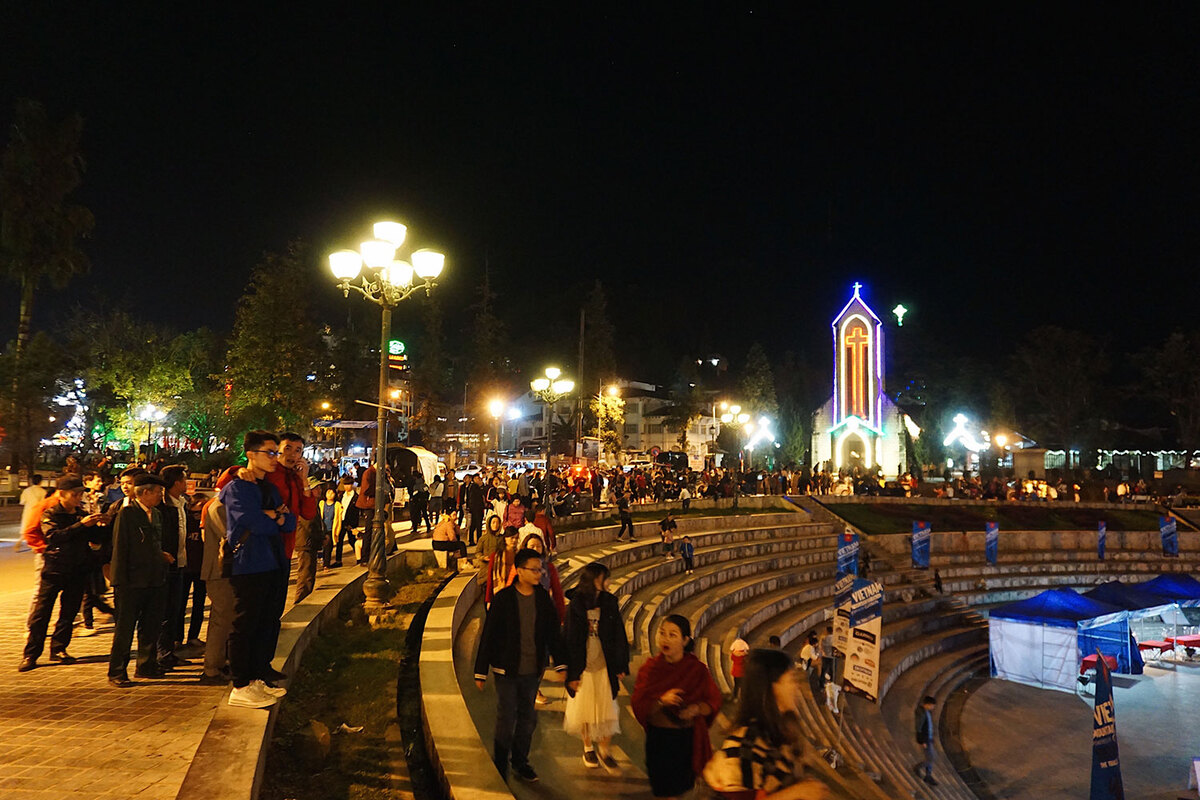
Sa Pa Square – a vibrant community space in the heart of the highland town. (Source: Collected)
6.3. Ancient Stone Church of Sa Pa
Right next to the square is the Sa Pa stone church, a structure built in the early 20th century in classic Roman Gothic architecture. The moss-covered stone walls and moss-roofed tiles over the years have become historical witnesses, marking the many changes of the highland town. Not only a place of worship for the local people, the church is also one of the iconic check-in spots, associated with the image of Sa Pa in the hearts of tourists.
6.4. Ta Van Village
Only about 8 km from Sa Pa town center, Ta Van village is home to the H'Mong, Red Dao, and Giay ethnic communities. The landscape here leaves an unforgettable impression on visitors with terraced fields stretching along the mountainside and simple wooden houses nestled beside the clear Muong Hoa stream.

The peaceful Ta Van village with lush terraced fields. (Source: Collected)
Visiting Ta Van, you will not only admire the natural beauty but also have the opportunity to explore the local culture through traditional cuisine, handicrafts, and the simple life of the people. This is an ideal destination for those who love community-based tourism and wish to immerse themselves in the pristine, peaceful beauty of the Northwest mountains.
The Sa Pa Museum not only preserves ancient memories but also opens a door for visitors to touch the soul of Northwest culture. A stop here will make your journey to explore Sa Pa more profound, complete, and unforgettable.

